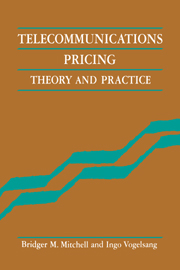Book contents
- Frontmatter
- Contents
- List of figures
- List of tables
- Acknowledgments
- I PRICING AND TELECOMMUNICATIONS
- II RECENT DEVELOPMENTS IN THE NORMATIVE ECONOMIC THEORY OF TARIFFS
- III TELEPHONE RATE STRUCTURES IN THE UNITED STATES
- IV SYNTHESIS
- 12 Synthesis of theory and practice
- A US telephone price indexes
- Bibliography
- Index
- Selected list of RAND books
12 - Synthesis of theory and practice
Published online by Cambridge University Press: 28 October 2009
- Frontmatter
- Contents
- List of figures
- List of tables
- Acknowledgments
- I PRICING AND TELECOMMUNICATIONS
- II RECENT DEVELOPMENTS IN THE NORMATIVE ECONOMIC THEORY OF TARIFFS
- III TELEPHONE RATE STRUCTURES IN THE UNITED STATES
- IV SYNTHESIS
- 12 Synthesis of theory and practice
- A US telephone price indexes
- Bibliography
- Index
- Selected list of RAND books
Summary
This study has provided an overview of recent developments in the economic theory of pricing and the innovative practice of setting telecommunications tariffs in the United States. In this final chapter we recapitulate the principal linkages between theory and practice and suggest how these tools can be applied to new pricing problems.
Lessons from pricing theory
Overview of theory
The benchmark for all public utility tariffs is marginal-cost prices, which are exemplified in telecommunications under the heading of peak-load pricing. Under the appropriate conditions marginal-cost prices are welfare maximizing; they are firmly based on cost; and they, and the rationale behind them, are easily understood. However, the simplicity of marginal-cost prices hides major conceptual difficulties, measurement problems, and potential inefficiencies. Potential inefficencies of marginal-cost pricing can arise because marginal-cost prices, due to longrun excess capacity or due to economies of scale and scope, rarely cover total cost of service.
Most of the literature assumes that the firm's pricing must cover its total costs without external subsidies. Budget constraints on the regulated telecommunications carrier or differentiated welfare weights in the objective function then lead to various versions of Ramsey pricing and of the inverse elasticity rule. This rule says that relative markups of prices over marginal costs for the various services offered should deviate in inverse proportion to the respective demand elasticities. This rule can be adapted in various ways to cases of interdependent demands, competitive situations, situations involving consumption externalities, and dynamic settings. Also, it holds for both welfare-maximizing and profit-maximizing behavior. Thus the inverse elasticity rule, properly interpreted, is a surprisingly robust concept. Consumption externalities and learning-by-doing, however, lead to additional terms in the pricing equation under welfare maximization, terms that are absent under profit maximization.
Information
- Type
- Chapter
- Information
- Telecommunications PricingTheory and Practice, pp. 249 - 263Publisher: Cambridge University PressPrint publication year: 1991
